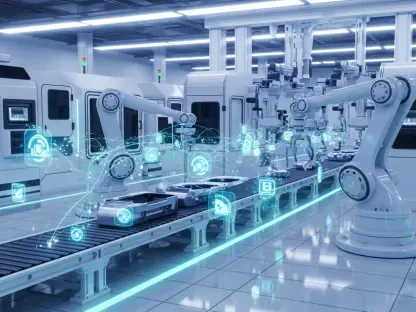In an era where industrial automation is becoming increasingly complex, the demand for solutions that can seamlessly integrate diverse systems and adapt to evolving production needs has never been higher. Imagine a manufacturing floor where assembly lines, machinery, and data analytics operate in perfect harmony, driven by a single, powerful device capable of handling multifaceted tasks with ease. This is the promise of Festo’s latest innovation, a groundbreaking edge device known as the CEPE, introduced as part of the AX Controller range. As a high-performance industrial PC and control unit, it represents a significant leap forward in addressing the challenges of modern industrial environments. Designed to streamline processes like pick-and-place operations and predictive maintenance, this technology is poised to redefine efficiency. This article delves into the transformative capabilities of this edge device, exploring its role in enhancing automation and its alignment with broader industry trends.
Unveiling the Core Features of Festo’s Edge Device
Harnessing Advanced Hardware for Diverse Applications
The CEPE stands out as a robust solution tailored for a wide array of industrial applications, from palletizing to servo presses. At its core, this edge device combines high processing power with Intel i3 processors, ensuring that it can manage complex tasks without faltering. Its ability to support local data analysis reduces reliance on external systems, thereby enhancing operational speed and reliability. Beyond raw power, the device offers a variety of interfaces that facilitate seamless integration into existing control architectures. Compatibility with communication protocols such as Profinet, Ethernet/IP, and EtherCAT ensures that it can communicate effectively across diverse systems. Additionally, secure data exchange through OPC UA standards adds a layer of cybersecurity, addressing a critical concern in today’s connected industrial landscape. This combination of hardware prowess and connectivity options positions the CEPE as a versatile tool, capable of meeting the dynamic demands of modern production floors with precision and adaptability.
Empowering Flexibility Through Open Architecture
Complementing its hardware strengths, the CEPE is built on an open ecosystem that prioritizes flexibility and customization. Leveraging the Festo AX operating system, which is based on PLCnext Technology, it supports programming in modern languages like C++, C#, Python, and the IEC61131 family. This allows developers to create tailored applications that address specific automation challenges. The Linux-based OS further enhances this adaptability by supporting containerized runtime environments, which promote modularity while maintaining real-time performance. Cloud connectivity features enable integration with broader data ecosystems, ensuring that insights can be shared and acted upon swiftly. Such an open architecture not only simplifies the development process but also fosters innovation by allowing third-party tools and software to be incorporated effortlessly. As a result, industries can respond to shorter development cycles and increasing production complexity with solutions that are both scalable and future-ready.
Exploring the Impact on Industrial Automation Trends
Bridging the Gap Between IT and OT Convergence
One of the most pressing trends in industrial automation is the convergence of Information Technology (IT) and Operational Technology (OT), a challenge that the CEPE addresses with remarkable efficiency. By integrating robust hardware with an open control architecture, this device creates a seamless bridge between traditionally separate domains. This integration enables real-time data acquisition and analysis directly on the shop floor, minimizing latency and enhancing decision-making processes. The ability to handle IoT data alongside motion control tasks means that production environments can achieve greater transparency and responsiveness. Such capabilities are vital in an era where data-driven insights are becoming the backbone of operational success. With the CEPE, manufacturers gain a tool that not only aligns with current IT-OT integration needs but also anticipates future demands by offering scalability through software and hardware expansions, ensuring long-term relevance in a rapidly evolving field.
Driving Efficiency with Scalable Platform Integration
Another transformative aspect of the CEPE lies in its deep integration with the broader Festo AX platform, which encompasses a suite of software modules designed to enhance automation workflows. This platform provides access to a range of applications, including motion control and machine visualization tools, as well as AI-driven solutions for predictive maintenance. Available through an online catalog, these resources empower users to customize their automation systems to meet specific requirements. The scalability of this ecosystem means that businesses can start with essential functionalities and expand as needs grow, without overhauling existing setups. High configurability ensures that the CEPE can adapt to various control architectures, making it a practical choice for both end users and machine builders. By consolidating control, data integration, and advanced analytics into a single platform, this edge device significantly reduces operational complexity, paving the way for streamlined processes and improved productivity across industrial sectors.
Reflecting on a Milestone in Automation Innovation
Looking back, the introduction of the CEPE marked a pivotal moment in the journey of industrial automation, showcasing how far technology has come in addressing intricate production challenges. Its blend of high-performance hardware, open architecture, and seamless platform integration demonstrated a clear understanding of the industry’s evolving landscape. The device’s ability to handle diverse tasks—ranging from motion control to IoT data analysis—while maintaining flexibility through multiple communication protocols was a testament to thoughtful engineering. Compatibility with modern programming languages and secure data standards further solidified its position as a forward-thinking solution. As industries grappled with the need for quicker adaptation and enhanced efficiency, the CEPE stood out as a reliable partner, offering tools that met immediate needs while laying the groundwork for future advancements. Moving forward, exploring how such innovations could further integrate with emerging technologies like edge AI or advanced robotics presents an exciting opportunity for continued progress.









